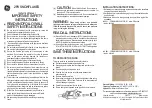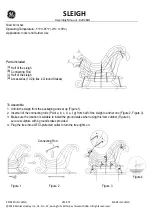
17
a brand of Hugo Lahme GmbH
Art. Nr.: 577701
Stand 08/2010
1. POSITION
It is recommended to place the pump of the counter-current in a way that the connection between the pump and the
fitting parts is as short as possible. In any case you have to ensure that the pump is installed in a manner that the
axle is in a horizontal position. Changing the place of the pump is possible due to construction reasons.
We recommend not to go beyond 5 m maximum distance for avoiding any higher flow reduction on the suction side.
While placing the installation please ensure that the pipes in that maximum area are passed without breakes and
in a horizontal way. If there are larger distances, you have to increase the diametre of the pipes. The place of
the pump has to be an area, where the ambient temperature does not exeed 40°C. Place the pump under the
water level because the pump does not suck itself. The pump and the locking parts have to be accessible any time.
Ventilation and drainage as well as floor drain have to be provided in the pump shaft.
2. INSTALLATION
The equipment is supplied as standard with all nessary fittings. The wall pack is suitable for 240 / 250 mm
concrete wall. The wall pack should be mounted in a way that the centre of the nozzle is between
200 and 250 mm below water level and is not placed less than 1,5 m from the side wall.
After finishing of the construction and cleaning of the fitting parts, you may assemble the unit.
The air and sensor connection of the fitting have to be connected with the transitions in the wall pack.
When pushing the fitting in, the hoses may not get broken. Fix the fitting by using the delivered screws
on the wall pack. Now, the non-return-valve in the pump shaft has to be connected to the air hose.
The non-return-valve has to be installed above water level. The sensor cable has to be connected to
the control box. Fix the suction sieve with the delivered screws on the wall pack. The connection between
the pump and the wall kit is made according to the drawing and part list. The piping is made on site.
3. STARTING UP
Ensure that the pool is full of water before starting up the pump. Avoid any dry run of the pump.
1. Open both valves and turn on the installation by using the sensor switch.
2. Check the air injection.
3. Check the regulation of the quantity.
4. Hose and tube connections have to be checked on leakage during the working process. Due to temperature
differences tighting of the connections can get neccessary. (Check the system on leakage by reducing the installation
as much as possible).
4. OPERATING
It is switched on and off by using the sensor switch. The air regulator enables to mix the air into the water jet. The intensity of the
water jet is adjusted by the quantity regulation. The nozzle can be adjusted in the direction. Adjust the current speed in a way that
the swimmer can swim against the full jet.
5. HIBERNATION
The pump has to be empty. Close both valves and open the screw on the housing of the pump for emptying.
6. POSSIBLE PROBLEMS AND SOLUTIONS
6-1. Installation does not produce sufficient power:
Pump is turning in the wrong direction. Water level is too low.
Pump sucks in air. Valve is not completly open. Suction pipe leaks. Pump is clogged (with leaves for instance).
If the causes can not be identified, inform the service responsible.
6-2. Pump can not be switched on:
Check the cable between the sensor switch and the control and check the configuration
of the connection of the control.
6-3. Relay for motor protection switches off:
Relay for motor protection
is not adjusted correctly. Rated current and local situations
have to be consistent with the adjustment of the relay for motor protection. Pump is overheated. Cool down the motor and
start it again. Phase failed - check the fuses.
6-4. Residual Current Device (RCD) switches off:
The equipment has to be checked by an electrician.
Installation instructions




































